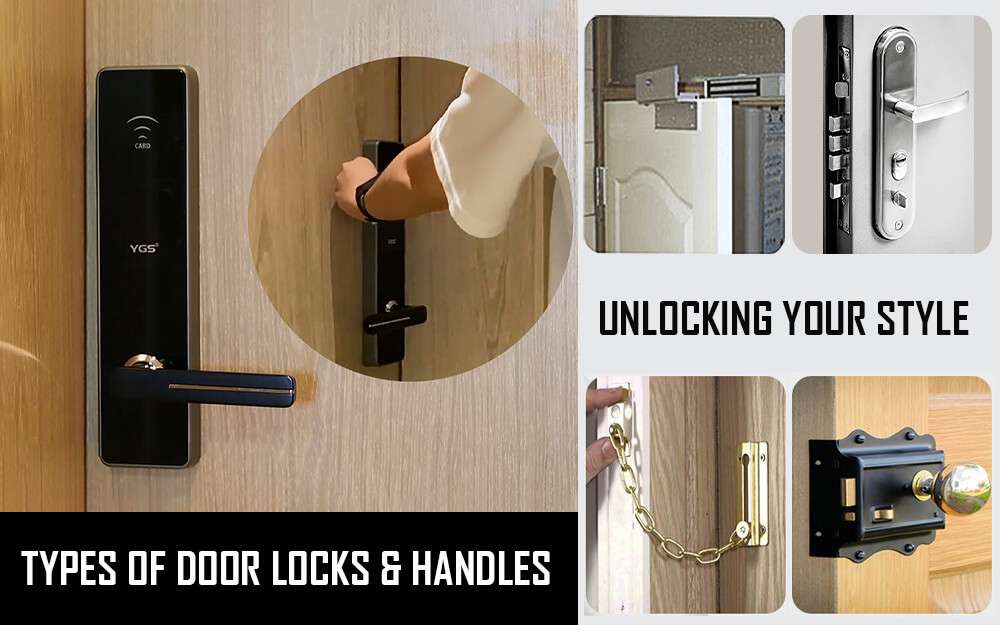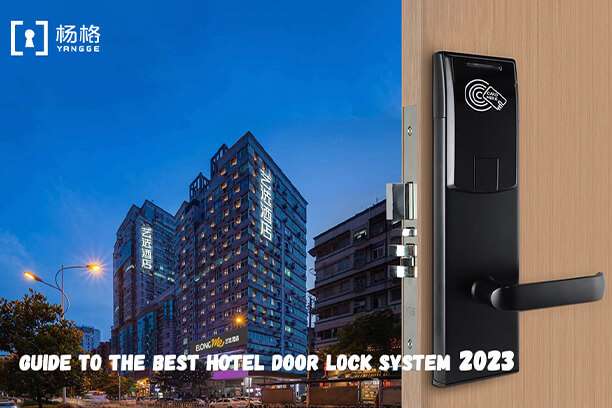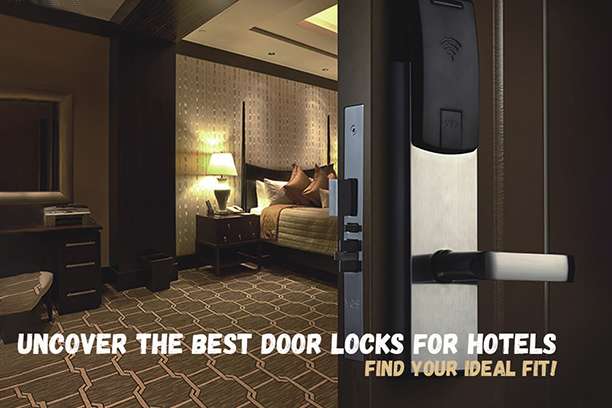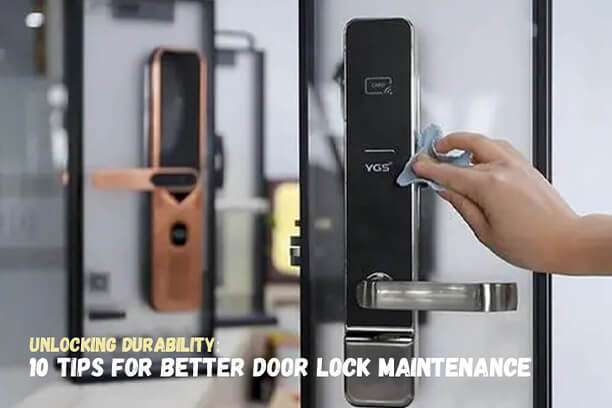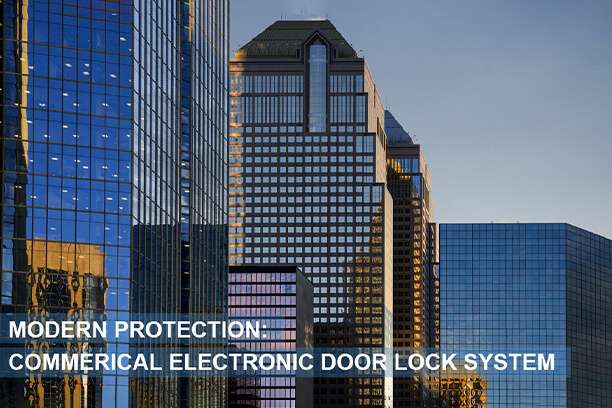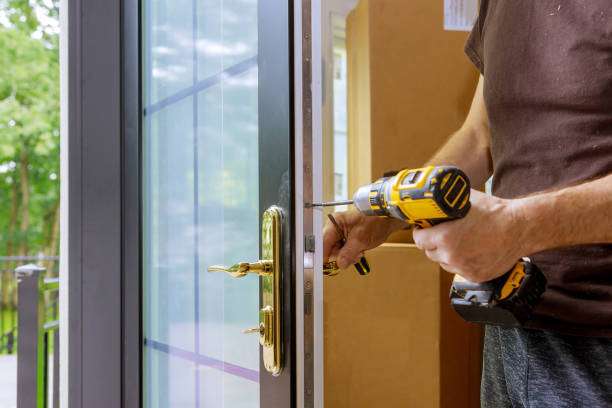When it comes to modern building security, door locks have become indispensable. Whether it’s your home or a commercial space, door locks are the primary choice for protecting your privacy and property. In this guide, we’ll delve into the realm of door hardware, examining different types of locks and handles, and demonstrating their optimal uses in various situations. Furthermore, we’ll offer you guidance on purchasing to assist you in crafting a secure and appealing environment for your space.
1. Knob Lock
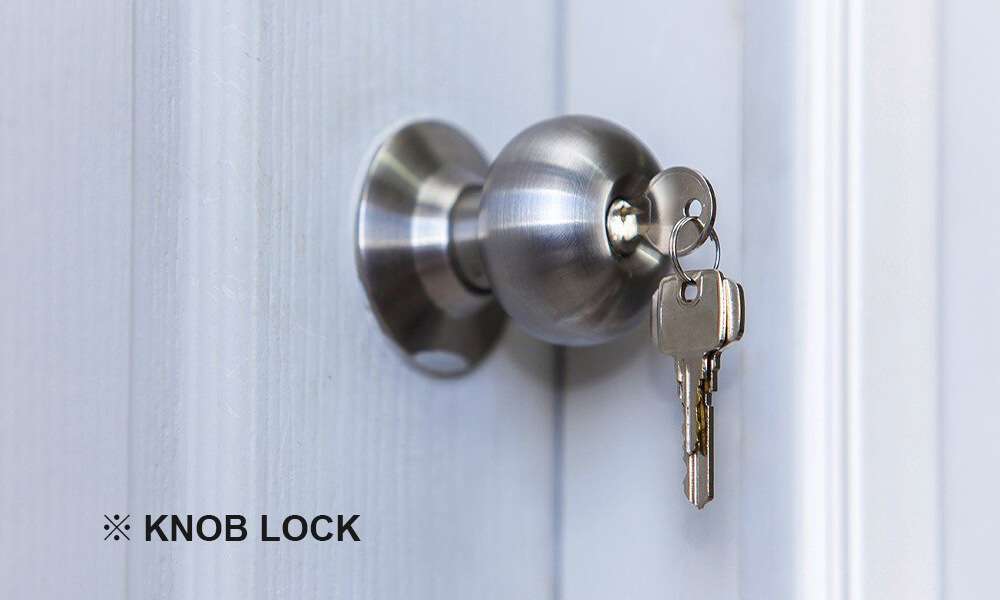
A knob lock is a frequently used type of door lock characterized by its straightforward design. In this type of lock, the lock mechanism and the handle are combined, typically in a circular shape. Due to its simple manufacturing process, it’s cost-effective.
However, due to relatively poor security performance, it’s typically not advisable for use on exterior doors. Instead, it’s better suited for interior doors, such as those found in bathroom doors and bedroom doors.
This type of door lock is unlocked by inserting the corresponding key and turning the lock core. Once the correct key is used, you can easily turn the knob to retract the latch from the door frame, completing the opening action.
2. Cam Lock
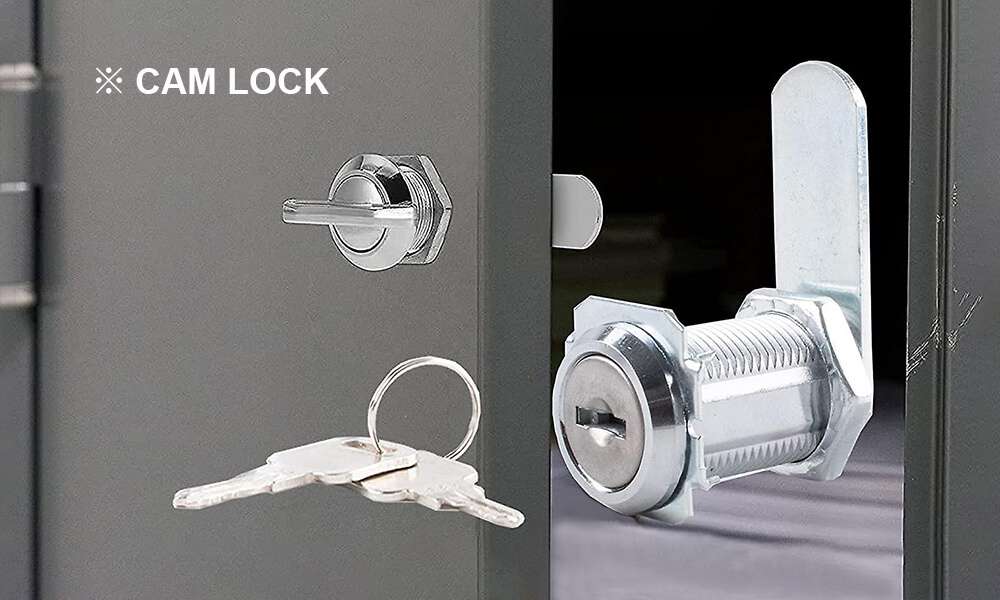
Also known as a cam lock or latch lock, it’s a type of locking lever used to secure doors. Its body consists of a metal piece with a cam, attached to the core of the lock, which rotates with the insertion and turning of a mechanical key. When the latch rotates 90 to 180 degrees, it can lock and unlock the door.
This type of lock is relatively simple and typically doesn’t include a handle, so an additional handle is needed. Common uses include lockers, safes, windows, cabinets, filing cabinets, etc.
3. Slide Latch Lock
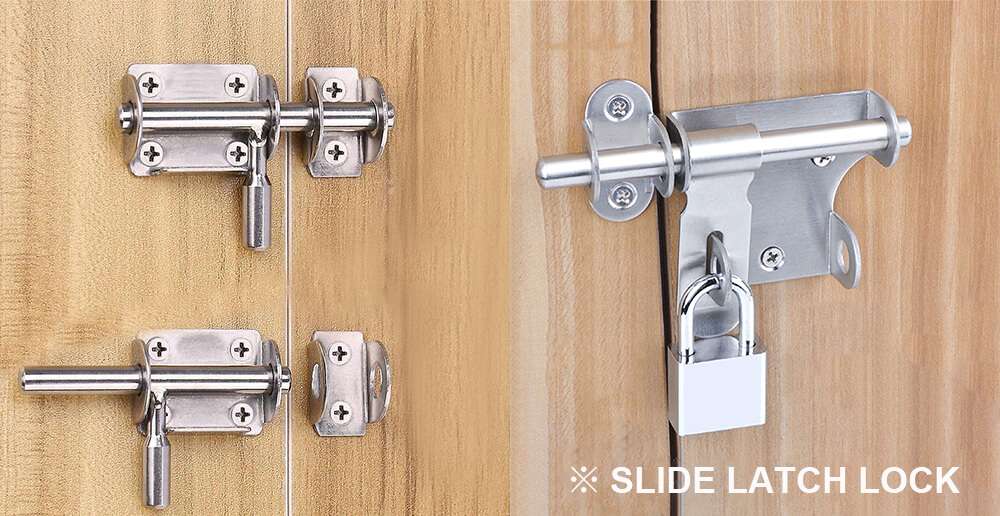
A slide latch lock is a simple yet effective security component for doors. It consists of two main parts: a part with a movable bolt and a lock hole mounted on the door frame. Usually, the part with the bolt is fixed to the door, while the lock hole is fixed to the door frame, with their corresponding positions.
When the door is closed, inserting the bolt into the lock hole locks the door; when the door needs to be opened, simply retract the bolt. For extra security, people often combine this deadbolt lock with other types of locks such as padlocks, electronic locks, etc.
Slide latch locks are typically made of a single material, with common colors. Nevertheless, their structure is relatively robust and very easy to use. While more sophisticated anti-theft locks are now prevalent, slide latch locks remain popular choices for securing areas such as public restrooms and warehouse doors.
4. Mortise Lock

A mortise lock is one of the most common door locks, typically consisting of a handle, lock core, and lock body. Due to its larger panel design, a mortise lock can be matched with different types of door handles to accommodate various style preferences. This type of lock is versatile and typically used on interior suite doors and security doors.
Among them, the lock core is the core component of the mortise lock, containing slots and springs. The slot is where you insert the key, and the spring keeps the slot steady. When the correct key is inserted into the mortise lock, the slot rotates to the correct position accordingly. This releases the latch, allowing the door to be opened.
Depending on the internal structure, mortise locks can generally be divided into several types such as single-latch mortise locks, double-latch mortise locks, and single-latch button mortise locks. Each type has its unique structure, performance features, and situations where they are most suitable for use.
5. Padlock
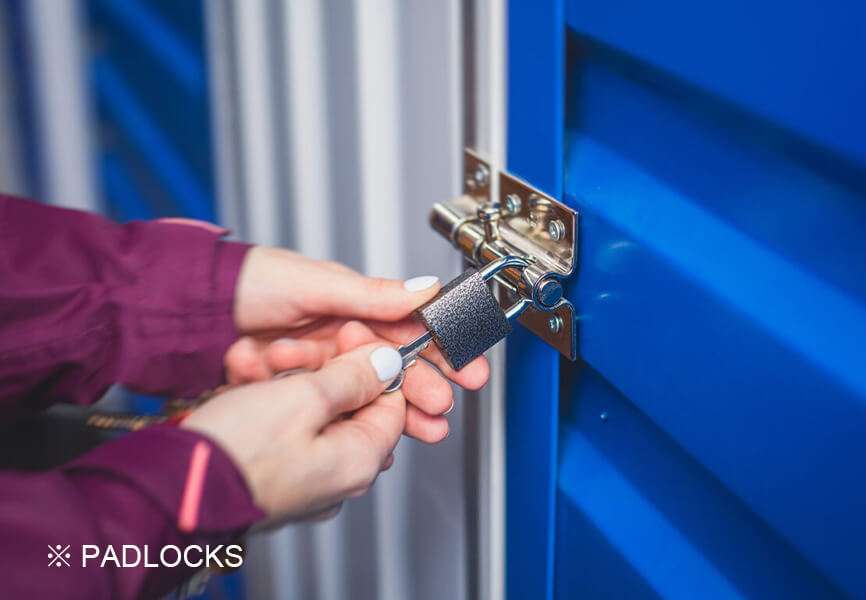
A padlock is a convenient and easy-to-use non-fixed lock, which can be divided into two types: key-controlled and combination.
- Key-controlled padlock: The principle is similar to that of a mortise lock. It consists primarily of a lock core, internal pins, and a corresponding key. When the key is inserted and turned correctly, the pins align to the proper positions, enabling the shackle to unlock and open the padlock.”
- Combination padlock: Typically only includes a rotating dial or button, without a key. Unlocking the device requires only rotating the dial according to the pre-set numerical combination.
Regardless of the type, padlocks rely on hooks on doors or other structures to lock. This type of lock is usually used in situations requiring temporary or portable security solutions, such as door handles, lockers, suitcases, etc.
6. Glass Door Lock
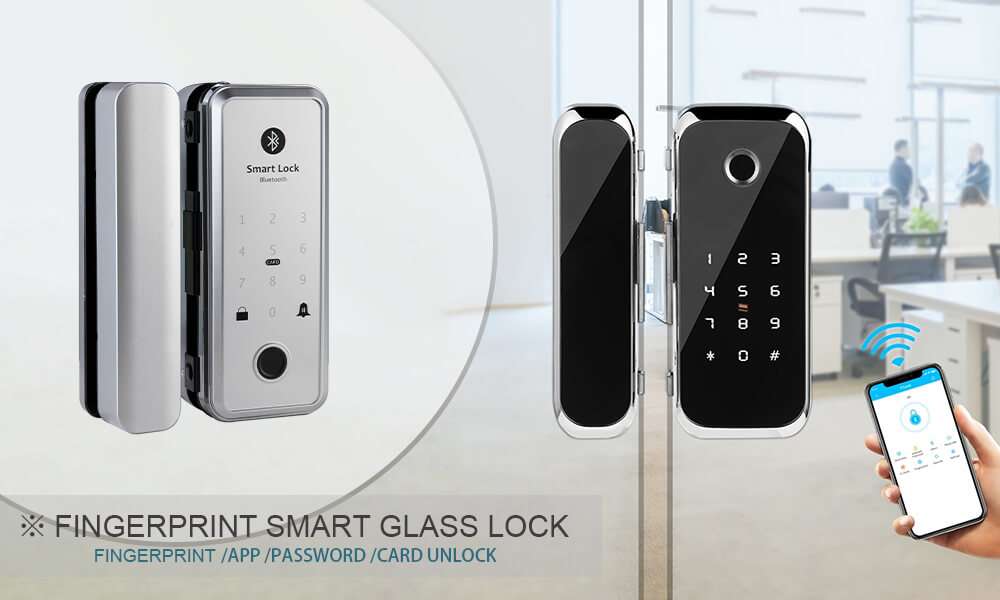
Glass door locks have become essential security devices for today’s popular glass doors. Glass door locks are specifically crafted to work seamlessly with glass doors and offer reliable security for private areas, unlike standard door locks.
They employ various special installation methods suitable for different types of doors, such as tempered glass doors, sliding glass doors, and framed glass doors.
There are various styles of glass door locks, including clamping, magnetic, and key-operated types. Each type has its unique features and security performance. Some come with built-in handles, while others require additional handles.
- Clamping glass door lock: Fixed on the glass door by clamping or pressing. The lock comes with clamps or pressure plates designed to securely attach it to the edge or surface of a glass door, preventing it from being pushed open. This lock can be installed on single-sided or double-sided glass doors, with easy installation and no need for drilling.
- Magnetic glass door lock: Uses magnetic principles to keep the door closed. Typically, magnetic components are installed on the glass door. When the door is closed, these components adhere together to keep the door closed. Common methods for opening doors typically include using keys or magnetic cards. When the card is successfully scanned, the magnetic components of the door are disengaged, allowing the door to be unlocked.
- Mechanical key glass door lock: Standard cylinder lock mechanism. Insert a key into the lock core and rotate it to release the locking mechanism. This type of lock may require special installation to ensure that drilling holes in the glass do not damage or weaken its structure.
7. Smart Door Lock
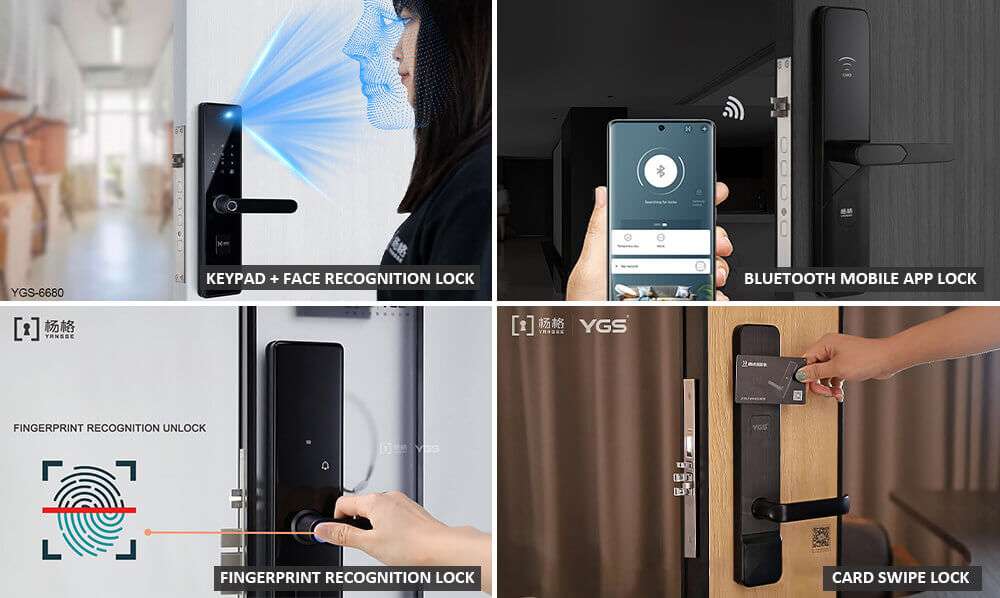
A smart door lock enhances standard mechanical locks by adding intelligence and convenience to user security, recognition, and management. It can be unlocked using traditional mechanical keys and integrates various advanced unlocking methods such as passwords, fingerprint recognition, facial recognition, and RFID cards.
Many smart locks also support wireless communication technologies such as Wi-Fi, Bluetooth, Z-Wave, or NFC. This allows them to seamlessly integrate with other smart devices (such as smartphones and smart home controllers), providing users with a smarter and more convenient door lock experience.
The smart door lock market offers a diverse range of choices, including different types and styles. Besides enhancing user convenience, they also add a surprise element to architectural spaces, enhancing the overall aesthetic.
Smart door locks are currently the most popular type of electronic door locks on the market. They’re widely utilized in private homes, commercial buildings, offices, and rental properties.
8. Electric Lock

An electric lock is a mechanical locking device operated by a relay. It encompasses various structured products such as electric rim locks, magnetic locks, and electric drop bolt locks.
They each have their characteristics in terms of installation, usage, and application:
- Electric rim lock: Unlocks automatically when the power is cut. Usually controlled by an electric motor or electromagnet, pulling or pushing the bolt to unlock. Suitable for situations requiring quick unlocking, such as emergency evacuation routes or fire doors.
- Magnetic lock: Uses the attraction between an electromagnet and an iron block to close the door, also known as a fail-safe electric lock. The electromagnet is mounted on the door frame, while either an iron core or suction cup is installed on the door itself. A strong magnetic force is generated to secure the door shut when the power is connected. Typically used for wooden doors, fire doors, and glass doors.
- Electric drop bolt lock: A mechanical lock device controlled by a relay, unlocking the door by controlling the current. Provides an extra layer of security, and can be integrated with various access control systems. Suitable for residential homes, commercial buildings, schools, hospitals, etc., providing convenient access control solutions.
In terms of installation, all three lock types need to consider compatibility with door frames and doors, power supply, control system installation, and relevant safety standards and regulatory requirements.
In terms of application, electric plug locks are suitable for situations requiring quick unlocking, magnetic locks for situations requiring forced locking, and electric control locks for situations requiring high security and flexible access control.
Diverse Types of Door Handles
Door handles are one of the essential decorations in our daily lives. They beautify doors and enhance the convenience of people’s home lives. There are many types of modern door handles on the market, each presenting different aesthetics and prices.
Below, we categorize them based on material and shape:
By Material:
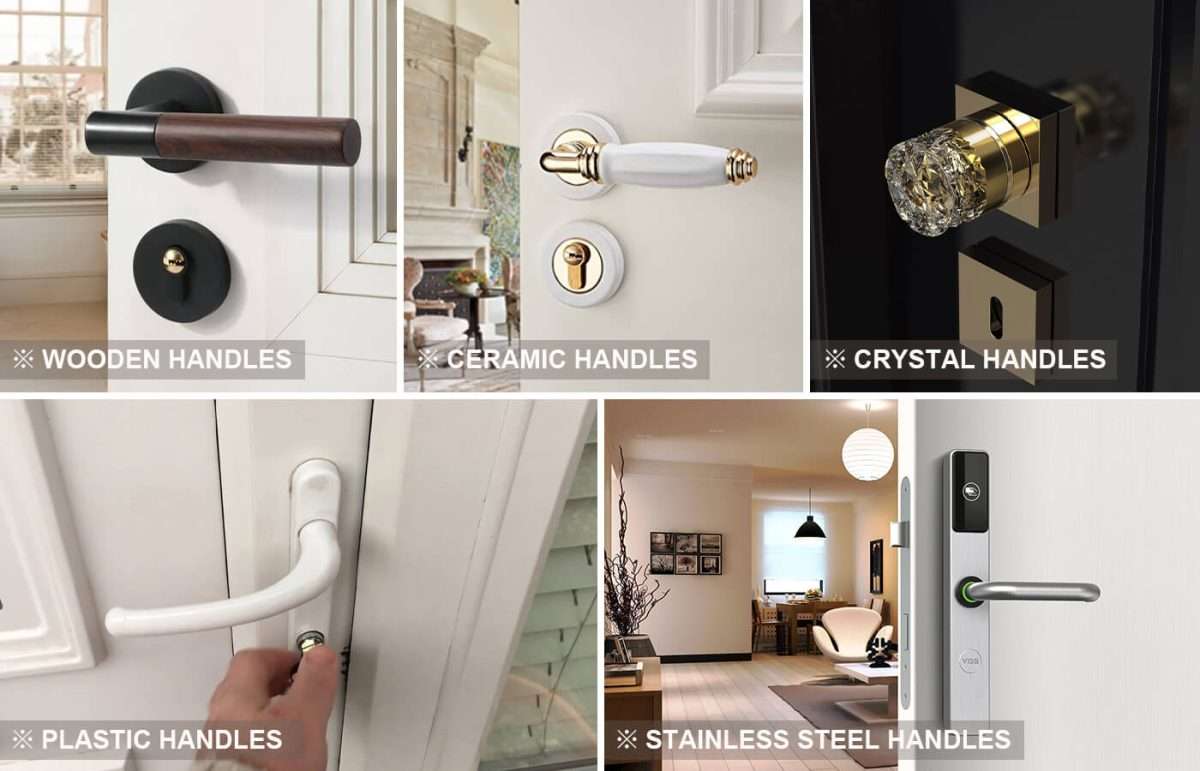
1. Plastic Handles:
Plastic handles are made of plastic or resin as the main material, and manufactured through injection molding machines. They can be designed with specific shape requirements, and molded in one go. Since plastic is relatively more economical compared to other materials, the cost of plastic door handles is usually lower.
However, plastic ones are less durable than metal or wooden door handles, not resistant to high temperatures, and prone to deformation. Therefore, their usage rate is relatively lower, usually appearing as part of exterior combinations. For example, they’re often paired with zinc alloy and built using techniques like spraying, electroplating, or painting.
2. Hardware Handles:
Refers to various metal components made from metals such as aluminum, titanium, or steel through forging, rolling, cutting, and other physical processes. Some common hardware products include:
- Stainless Steel Handles: They possess characteristics of corrosion resistance, wear resistance, and durability. They typically have a modern and minimalist appearance, suitable for modern-style decoration. Commonly found in places like kitchens, bathrooms, and outdoor doors, where corrosion resistance and easy cleaning are needed.
- Aluminum Alloy Handles: These materials are lightweight yet durable, offering excellent resistance to corrosion and ease of processing. They can be molded into different shapes and styles, making them versatile for various applications. Typically employed in interior doors, furniture, and cabinets, they complement various decorative styles.
- Brass Handles: Usually glossy, with good texture, oxidation resistance, and processability. Over time, brass handles develop a natural patina, adding a retro and classical aesthetic. Commonly found in retro or classical-style home decorations, such as classical furniture, classical doors, etc.
- Brushed Stainless Steel Handles: The surface of brushed stainless steel handles presents delicate textures, with characteristics of scratch resistance and easy cleaning. They typically have a modern and minimalist appearance, commonly found in modern-style home decorations, such as modern doors, cabinets, etc.
3. Wooden Handles:
Usually made from natural wood such as oak, pine, or beech. These woods are known for their durability, excellent texture, and smooth surface. Retaining the natural texture and color of the wood gives a sense of nature and simplicity.
Especially suitable for traditional, country, Nordic, and other styles of decoration, adding aesthetic appeal and highlighting style characteristics. Some wooden handles may also incorporate decorations made of metal or other materials, adding practicality.
4. Crystal Handles:
Made from natural or synthetic materials with high transparency and excellent optical properties. They are characterized by gorgeousness, transparency, high gloss, and durability. The reflective effect under light makes them shine brilliantly, enhancing the room’s visual appeal and giving it a more elegant and high-end appearance.
Due to their high-quality materials and expert craftsmanship, crystal handles are relatively expensive and are typically considered upscale luxury decor. They are commonly found in high-end residential properties, hotels, or places like hotels to enhance the overall quality of decoration.
5. Ceramic Handles:
Usually made of ceramics, often glazed ceramics with smooth and easy-to-clean surfaces. Depending on the manufacturer and designer’s choice, they can be handmade or machine-produced.
Ceramic handles come in rich colors and diverse patterns, adding an artistic atmosphere to doors. They are suitable for literary or classical-style decoration, such as classical hotels, restaurants, art galleries, etc.
By Shape:
1. Lever Handles:
Lever handles are the most common type of door handles, typically consisting of a fixed rod on the door. These rods are mainly divided into straight and curved forms. Users can easily open or close the door by moving the handle rod vertically or horizontally.
- Straight lever handles have a simple and direct look, often found in modern decorative designs, offering a minimalist yet stylish aesthetic.
- Curved lever handles feature gentle curves and rounded edges, ideal for decorating styles that aim for comfort and warmth.
These door handles are designed to be simple and easy to use, thus they are deeply loved by people.

2. Spherical Handles:
Spherical handles are designed with a shape resembling a sphere or hemisphere. Their minimalist and practical design makes them easy to grip and suitable for various types of doors, including interior doors, exterior doors, and drawers. These handles typically consider ergonomics to ensure user comfort and convenience.
Moreover, spherical handles can also play a certain decorative role, as their appearance can match the style of the door, adding a simple yet stylish atmosphere to the overall decoration.
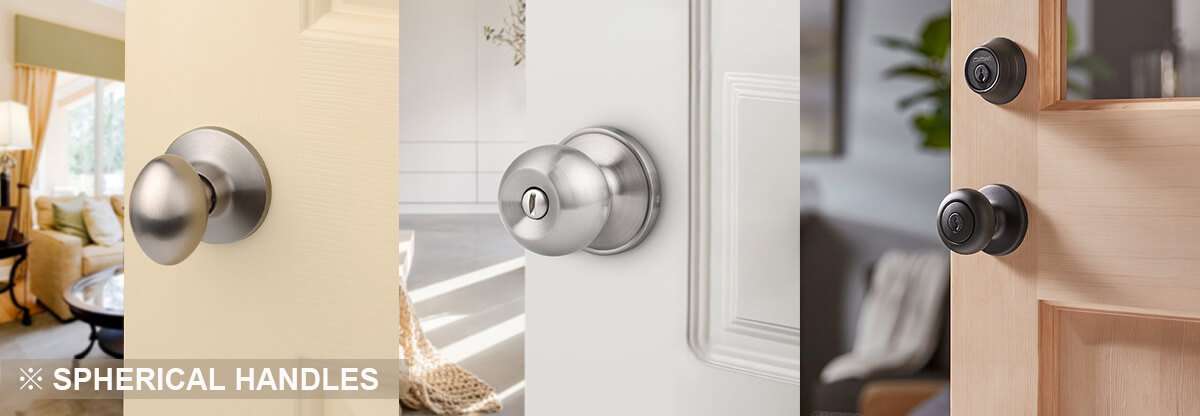
3. Push-pull Handles:
The design of these door locks aims to provide handheld operation, allowing users to grip and apply force to open or close the door. Push-pull door handles can come in various shapes, sizes, and styles to adapt to different types and styles of doors. Based on shape, they can be divided into straight-bar and curved forms.
- Straight-bar handles are designed as straight lines, sturdy, with a good grip feel, and suitable for operating sliding doors or heavy doors.
- Curved handles are designed with a certain curvature, fitting the arc of the hand for a more comfortable grip, commonly used for the decoration of common doors.

4. Other Aesthetic Types:
These types of door handles belong to artistic or customized aesthetic types, characterized mainly by personalization and interest. These door handles may adopt various shapes, including animal, plant, or other forms, to enhance the unique style and personality of the building.
Due to their customized nature, these door handles are usually designed to match specific architectural styles or cater to the aesthetic tastes of specific homeowners. Their design emphasizes not only functionality but also artistic and aesthetic sensations.

Door Locks and Handles:
Recommendations and Usage Scenarios
How should door locks be matched with handles? We can consider the following three aspects:
- Space Style:
Firstly, consider the overall decoration style of the space. The color of the selected door lock should be consistent with the decoration style of the space. This ensures a harmonious and noble atmosphere throughout the space by coordinating the details of the door lock with the entire room.
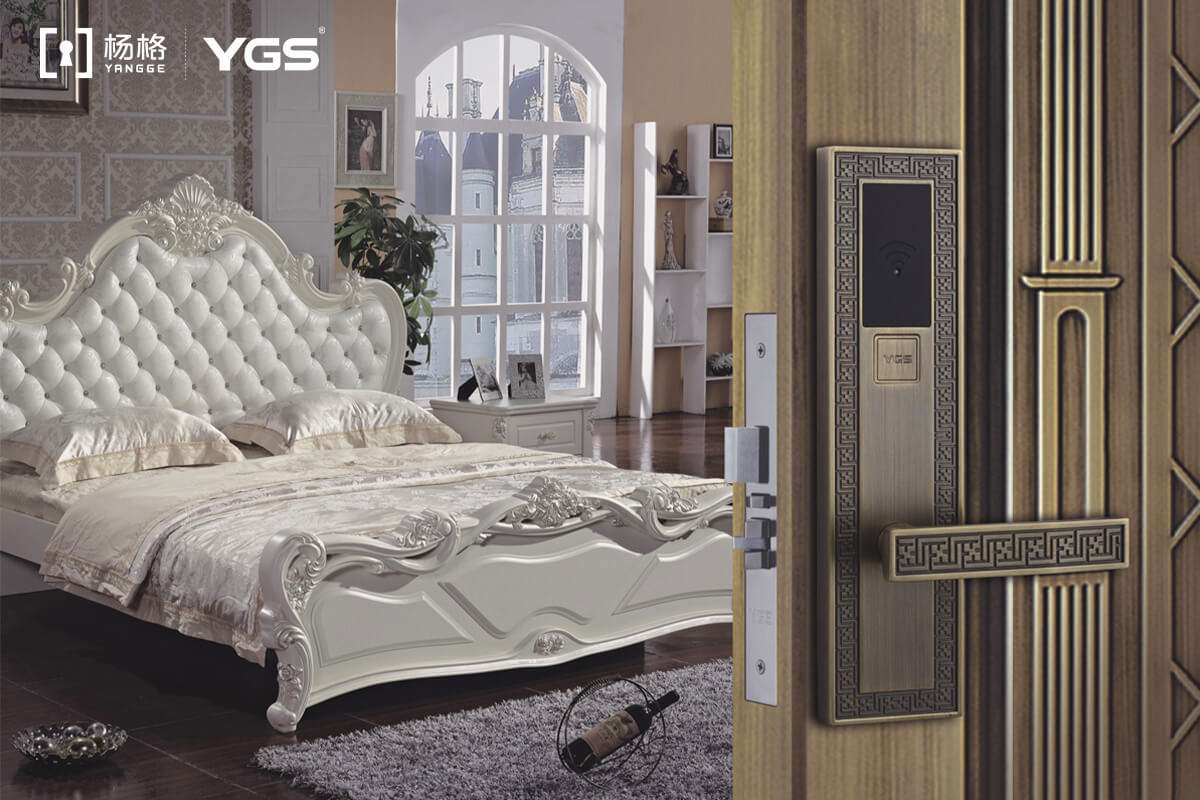
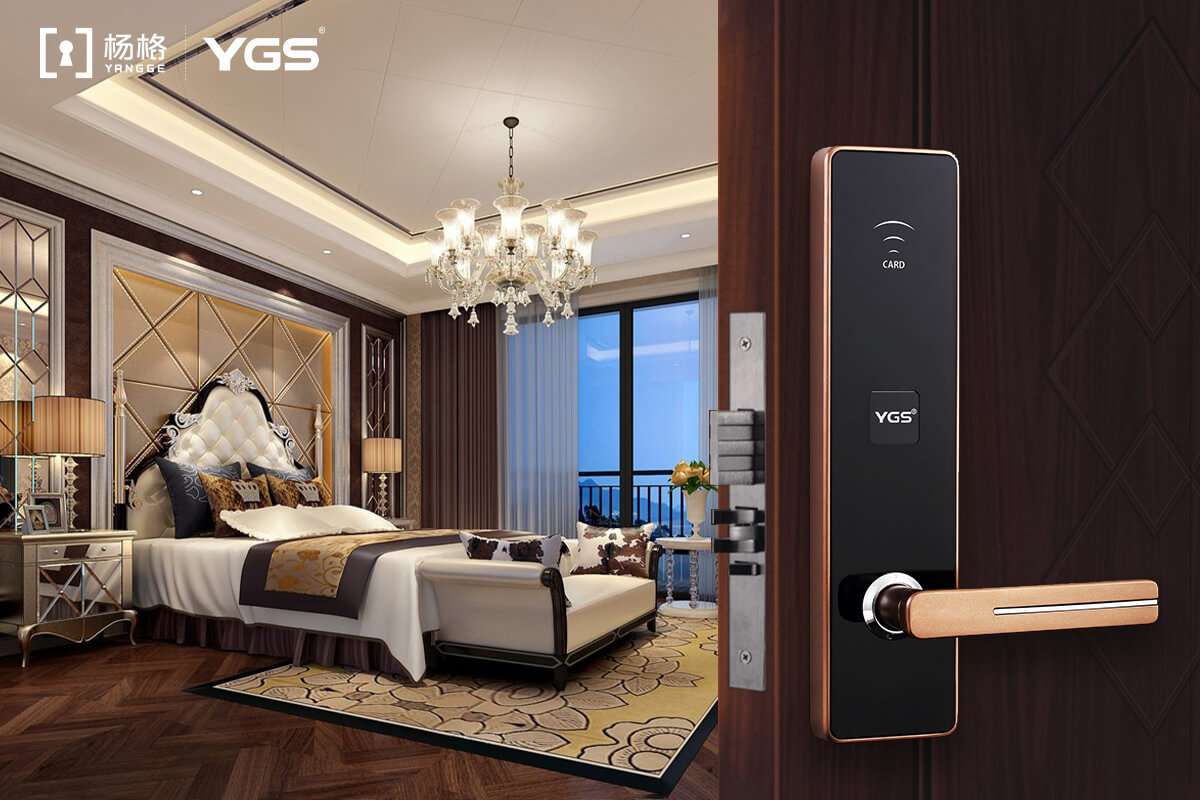
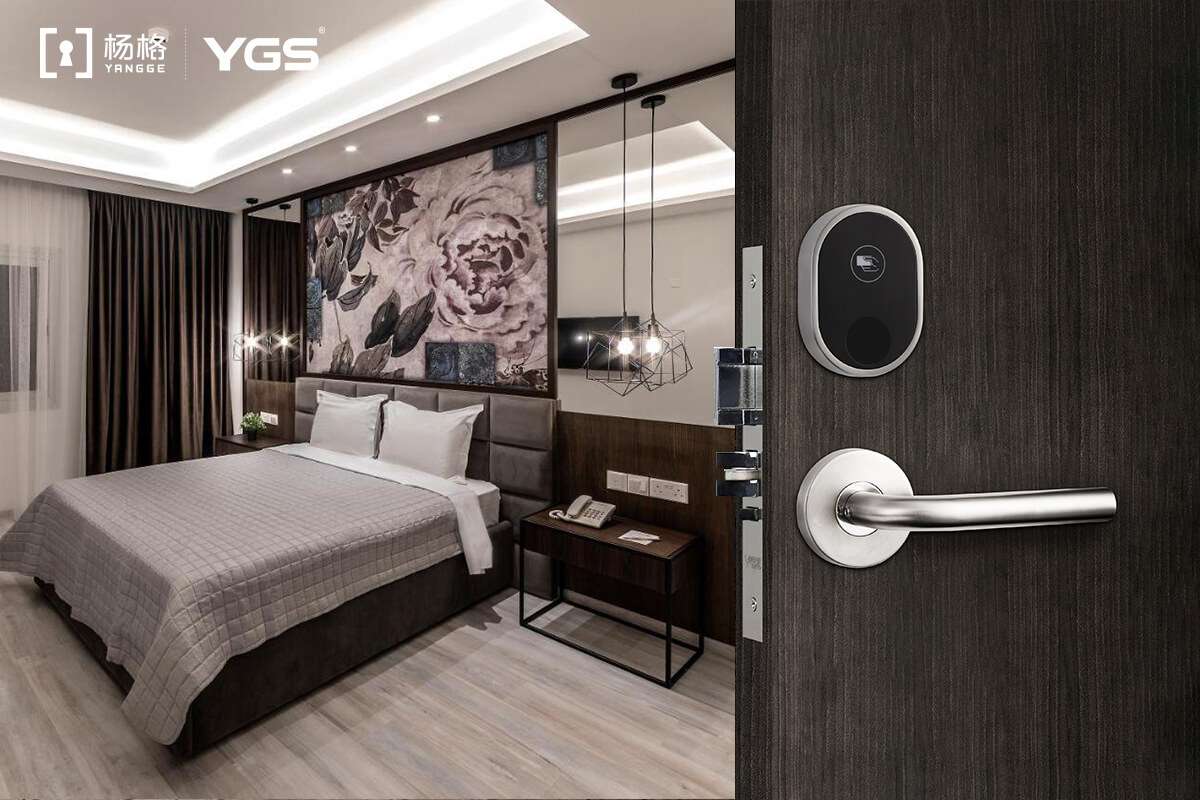
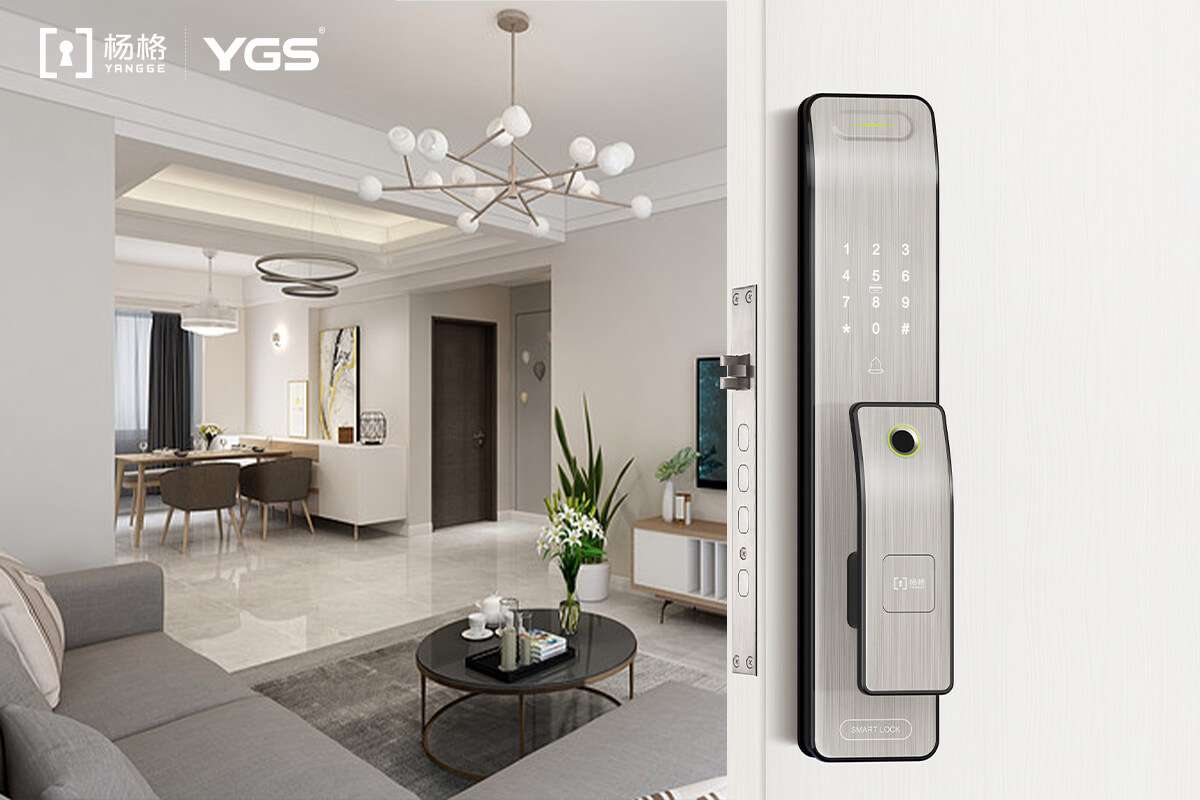
- Door Frame Color:
The door frame generally coordinates with the color of the baseboard, such as the popular black baseboard nowadays. If the door frame is black, choosing a black door lock will improve the overall integration of the door. The space will be more prominent, presenting a more harmonious effect.
- Door Color:
Common door colors include gray, white, and wood. For gray doors, choosing a black door lock can make the entire room appear understated yet noble, presenting a business style.
White doors with black handles are a great option, blending classic and modern styles for a sophisticated look. For dark wood-colored doors, like those found in American or Chinese styles, opting for gold door locks and handles will create a more cohesive and aesthetically pleasing look.
As for light wood-colored doors, there’s a wide range of colors that complement them quite well. Whether it’s gold, copper, or brass, any of these choices will give off a stylish and contemporary vibe.
Of course, these are just some reference suggestions. The specific choices should be made in conjunction with comprehensive factors such as the space style.
Factors in Choosing Door Locks and Handles
- Consideration of Installation Position:
Different installation positions require different types of door locks and handles.
When selecting door locks and handles for external doors, prioritize durability to withstand tough weather. Both anti-theft and intrusion prevention features are crucial for outdoor doors, as they serve as primary entry points to a house. They should be able to withstand physical attacks and prevent unauthorized entry, highlighting the significance of their security.
When selecting door locks and handles for internal doors, focus on decoration, comfort, and functionality. In damp areas like bathrooms, opt for corrosion-resistant locks to ensure durability. Since bathroom doors primarily serve privacy needs, prioritize keyless entry door locks and user-friendly options like latch or knob-style locks for easy access.
- Security Requirements:
If security is the primary concern for your building, you may need to choose a high-quality door lock. For example, choosing an electronic door lock or a traditional door lock with anti-pry function, the handle should be sturdy and resistant to damage.
- Style and Decorative Requirements:
Door locks and handles should match the overall decorative style of the room. You can choose door locks and handles of various materials and designs to ensure they coordinate with the interior decoration. For example, if the room adopts a modern style, you may choose door locks and handles with simple designs, while for traditional-style rooms, choosing styles with stronger decorative elements would be better.
- Emphasize Quality Issues:
Quality is one of the key factors to consider when choosing door locks and handles. Ensure to choose high-quality products produced by reliable manufacturers to ensure their durability and performance. Examine the materials, manufacturing processes, and performance of the products in addition to their appearance.
- Consider the User Group:
This is related to the requirements of the usage scenario, as different users may have different needs for the operation of door locks.
For young people, the more convenient functions the door lock has, such as unlocking with a mobile phone or biometric recognition, the better. Additionally, special door lock and handle styles will leave a lasting impression and provide comfort and pleasure.
In situations where older individuals are using the doors, it’s important to select door locks that are simple to operate and include handles. This will enable them to open and close the doors with ease.
Online Enquiry Form
Related Blog
With more than 20 years of smart lock experience, YGS could provide a set of hotel door lock management solutions for your hotel business.
Guide to the Best Hotel Door Lock System 2023
In today’s highly security-conscious society, hotel door lock systems have become an essential part of hotel security management. These systems provide guests with a high level of security and offer effective check-in management and security control tools for hotel management. The following…
Uncover the Best Door Locks for Hotels -Find Your Ideal Fit!
Currently, the hospitality industry is experiencing an unprecedented boom in the era of fully opened travel. As hotels face intense competition, it has become crucial to elevate guest experiences and prioritize safety measures, particularly when it comes to door locks for hotels. This article aims to provide…
Security Systems in Hotels – Smart Security for Safer Hotels
Recently, with the flourishing development of the global tourism industry, the hotel industry has undergone profound changes. A variety of hotel types have emerged in the market, including themed hotels, guesthouses, resort hotels, and more. Travelers have more options than ever before, as well as unique and memorable stay…
10 Tips for Better Door Lock Maintenance
Nowadays, smart locks are becoming increasingly widespread. Smart door locks are replacing traditional mechanical locks in more and more households, hotels, and apartments. Despite their strength and intelligence, smart door locks need proper maintenance and care daily, unlike mechanical locks. This article will focus on…
Modern Protection: Commercial Electronic Door Lock System
Security and access control are crucial in modern business. As enterprises expand, traditional access control methods fail to meet the growing demands of security. Therefore, the commercial electronic door lock system emerged and became a vital component of modern enterprise security management. This article delves into…
Hotels: how to replace door lock?
With the generational change in the hotel access control system, the old hotel door locks can no longer meet the needs of modern hotels. For convenience and safety considerations, many hotels decided to replace the old hotel system. So, how to replace door lock? This article will introduce you in detail from hardware to software…

